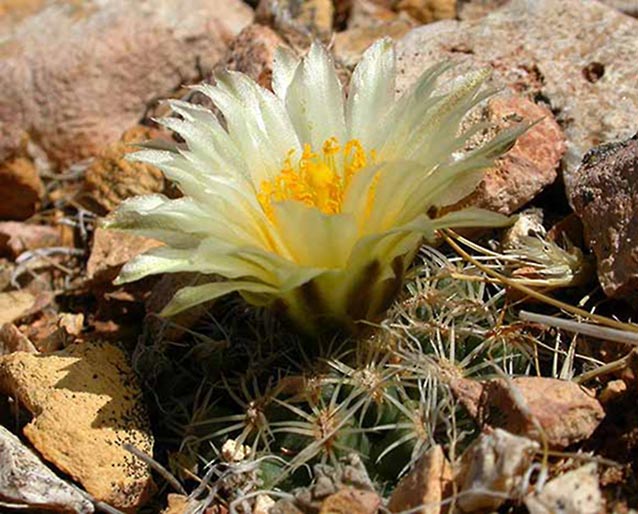Habitat and Ecology

© Christopher L. Christie
Brady’s pincushion cactus (Pediocactus bradyi) grows in scattered populations over a 70 km2 (27 mi2) area near Marble Canyon along the Colorado River in Arizona. Its soil requirements are specialized: it grows only on chips of Kaibab limestone that overlay soils derived from Moenkopi shale and sandstone outcrops. These soils occur along gently sloping benches at 1180 to 1370 m (3860 to 4490 ft) in elevation. The sites have sparse vegetation of low shrubs, annuals, and grasses. Brady’s pincushion cactus was only discovered in 1958 and historically may have occurred northeast along the Colorado River from its current distribution. Currently, it occurs in only 10-20% of its potential habitat.
Description
Brady’s pincushion cactus is an inconspicuous, rounded cactus. It usually has one stem that grows up to 6 cm (2.4 in) tall and 5 cm (2 in) in diameter. Clusters of fourteen to fifteen straw-colored spines radiate from a point that is elliptical in shape. The spines have comb-like hairs, and their tips point downward. From late March into April, a straw-yellow flower blooms at the end of each stem. The green fruit, which contains brownish-black seeds, turns reddish-brown at maturity, usually in late May to early June. During drought, the cactus retracts into the soil.
Conservation Status and Threats
The U.S. Fish and Wildlife Service has listed Brady’s pincushion cactus as an endangered species since October 26, 1979. Arizona lists the cactus as critically imperiled.
Brady’s pincushion cactus is primarily threatened by collectors of rare cacti, especially since populations are easily accessible from the highway. In addition, Brady’s pincushion cactus is threatened by off-road vehicles, uranium mining, and livestock grazing. Because it is restricted to a specific soil type and has a small gene pool, it is particularly vulnerable to extinction.
Related species
Winkler’s pincushion cactus (Pediocactus winkleri), its closest relative, has peach-colored flowers and fewer spines. In addition, the spines do not have comb-like hairs.
References
Arizona Game and Fish Department. 1994. Plant abstracts. Heritage Data Management System, Arizona Game and Fish Department, Phoenix, AZ. Available at http://www.azgfd.gov/w_c/edits/documents/Pedibrad. fo_000.pdf (accessed 14 June 2010).
Heil, D. K., and J. M. Porter. 1993. Pediocactus bradyi. Page 213 in Flora of North America. Volume 4. New York, NY, and Oxford, UK.
NatureServe. 2009. Pediocactus bradyi. NatureServe explorer: An online encyclopedia of life. Version 7.1. NatureServe, Arlington, VA. Available at http://www. natureserve.org/explorer/ (accessed 14 June 2010).
U.S. Fish and Wildlife Service. 1985. Brady pincushion cactus (Pediocactus bradyi) recovery plan. U.S. Fish and Wildlife Service, Albuquerque, NM. Available at http://www.fws.gov/ecos/ajax/docs/recovery_ plan/850328b.pdf (accessed 14 June 2010).
Prepared by Kelly Reeves, Southern Colorado Plateau Network Inventory and Monitoring Program, 2010.
Last updated: October 3, 2016
